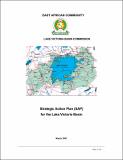| dc.description.abstract | This Strategic Action Plan (SAP) report for the Lake Victoria Basin (LVB) covers Burundi, Kenya, Rwanda,
Tanzania and Uganda. It was commissioned by the EAC Secretariat as part of the preparation for the LVEMP II
project. A Regional Transboundary Diagnostic Analysis (RTDA) for Lake Victoria Basin, conducted in 2006, was
used to identify Key Transboundary Issues (KTIs) and their causes. The TDAs provided the core baseline
information in the SAP for defining goals, targets, strategies and interventions for the KTIs.
Core, in the SAP, has been the prioritisation of the KTIs, which was based on the joint appraisal of the problems
and opportunities presented by biodiversity conservation and the sustainable management of Lake and LVB
resources, within a regional framework. This prioritisation guides national interventions, within the context of the
accepted Regional Programme.
This SAP addresses a shared regional concern, defines a regional framework for a Programme of Action, and
includes some immediate regional actions to address constraints for conserving natural resources and achieving
sustainable use of Basin resources. The SAP process went through a consultative that was driven by
stakeholders.
This SAP identifies five Thematic Areas for intervention of specific critical issues, which are: Ecosystems, Natural
Resources and Environment; Production and Income Generation; Living Conditions and Quality of Life;
Population and Demography; and Governance, Institutions and Policies.
The stakeholders had identified 18 KTIs which were subjected to a further prioritisation to come up with the
following ranked KTIs: Land, wetland and forest degradation; Governance, policy and institutional weakness;
Fisheries, habitats and biodiversity; Pollution, eutrophication and atmospheric deposition of the Lake from
domestic and industrial activities; and Water balance, water use management and climate change. The interventions were categorised with a view to clearly show, the timeframe (Short, Medium and Long Term);
Responsibility (National and Regional); Type/Category of intervention (Awareness, Economic Incentive,
Governance and Investment); Categorized cost of intervention (Low, Medium and High). Financing sources and
mobilization arrangements have also been outlined. Those interventions eligible to GEF funding have been
highlighted in the report.
It is our sincere belief that the action(s) identified for implementation, in this SAP, will lead to the transformation of
Lake Victoria Basin into a formidable economic growth zone in Africa and the world at large. | en_US |

